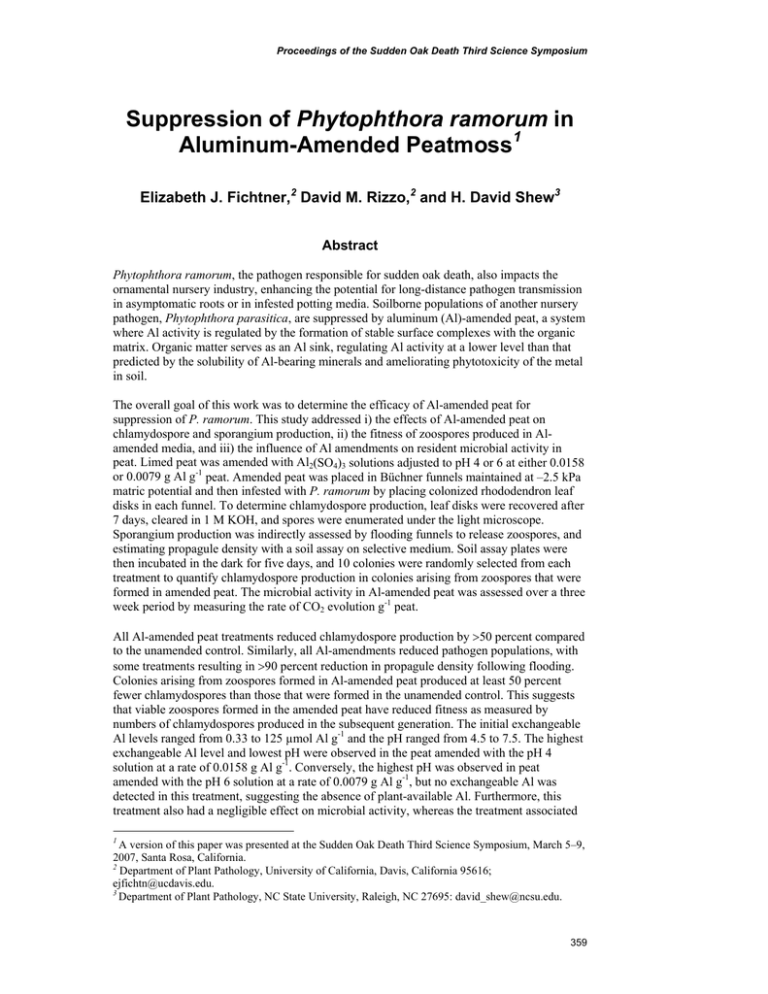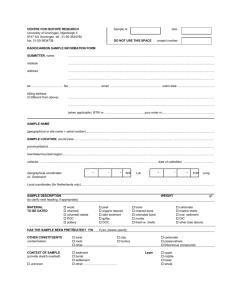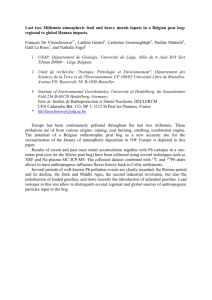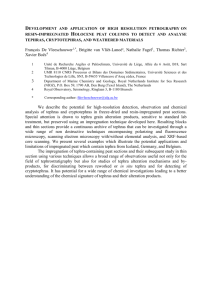Phytophthora Aluminum-Amended Peatmoss Elizabeth J. Fichtner,
advertisement

Proceedings of the Sudden Oak Death Third Science Symposium Suppression of Phytophthora ramorum in Aluminum-Amended Peatmoss1 Elizabeth J. Fichtner,2 David M. Rizzo,2 and H. David Shew3 Abstract Phytophthora ramorum, the pathogen responsible for sudden oak death, also impacts the ornamental nursery industry, enhancing the potential for long-distance pathogen transmission in asymptomatic roots or in infested potting media. Soilborne populations of another nursery pathogen, Phytophthora parasitica, are suppressed by aluminum (Al)-amended peat, a system where Al activity is regulated by the formation of stable surface complexes with the organic matrix. Organic matter serves as an Al sink, regulating Al activity at a lower level than that predicted by the solubility of Al-bearing minerals and ameliorating phytotoxicity of the metal in soil. The overall goal of this work was to determine the efficacy of Al-amended peat for suppression of P. ramorum. This study addressed i) the effects of Al-amended peat on chlamydospore and sporangium production, ii) the fitness of zoospores produced in Alamended media, and iii) the influence of Al amendments on resident microbial activity in peat. Limed peat was amended with Al2(SO4)3 solutions adjusted to pH 4 or 6 at either 0.0158 or 0.0079 g Al g-1 peat. Amended peat was placed in Büchner funnels maintained at –2.5 kPa matric potential and then infested with P. ramorum by placing colonized rhododendron leaf disks in each funnel. To determine chlamydospore production, leaf disks were recovered after 7 days, cleared in 1 M KOH, and spores were enumerated under the light microscope. Sporangium production was indirectly assessed by flooding funnels to release zoospores, and estimating propagule density with a soil assay on selective medium. Soil assay plates were then incubated in the dark for five days, and 10 colonies were randomly selected from each treatment to quantify chlamydospore production in colonies arising from zoospores that were formed in amended peat. The microbial activity in Al-amended peat was assessed over a three week period by measuring the rate of CO2 evolution g-1 peat. All Al-amended peat treatments reduced chlamydospore production by >50 percent compared to the unamended control. Similarly, all Al-amendments reduced pathogen populations, with some treatments resulting in >90 percent reduction in propagule density following flooding. Colonies arising from zoospores formed in Al-amended peat produced at least 50 percent fewer chlamydospores than those that were formed in the unamended control. This suggests that viable zoospores formed in the amended peat have reduced fitness as measured by numbers of chlamydospores produced in the subsequent generation. The initial exchangeable Al levels ranged from 0.33 to 125 µmol Al g-1 and the pH ranged from 4.5 to 7.5. The highest exchangeable Al level and lowest pH were observed in the peat amended with the pH 4 solution at a rate of 0.0158 g Al g-1. Conversely, the highest pH was observed in peat amended with the pH 6 solution at a rate of 0.0079 g Al g-1, but no exchangeable Al was detected in this treatment, suggesting the absence of plant-available Al. Furthermore, this treatment also had a negligible effect on microbial activity, whereas the treatment associated 1 A version of this paper was presented at the Sudden Oak Death Third Science Symposium, March 5–9, 2007, Santa Rosa, California. 2 Department of Plant Pathology, University of California, Davis, California 95616; ejfichtn@ucdavis.edu. 3 Department of Plant Pathology, NC State University, Raleigh, NC 27695: david_shew@ncsu.edu. 359 GENERAL TECHNICAL REPORT PSW-GTR-214 with the highest exchangeable Al level suppressed microbial activity. After 2 weeks, however, no difference in microbial activity was observed among treatments. Al-amended peat suppressed asexual reproduction of P. ramorum with low levels of exchangeable Al. In fact, pathogen suppression was even observed in treatments with no detectable exchangeable Al, suggesting that the stable surface complexes between monomeric Al species and acid functional groups on the organic matrix are suppressive to P. ramorum. Further studies are necessary to determine the mechanism of Al-mediated pathogen suppression and to assess its application in a disease management program. Key words: Phytophthora ramorum, Umbellularia californica, sudden oak death, survival, climate. 360









